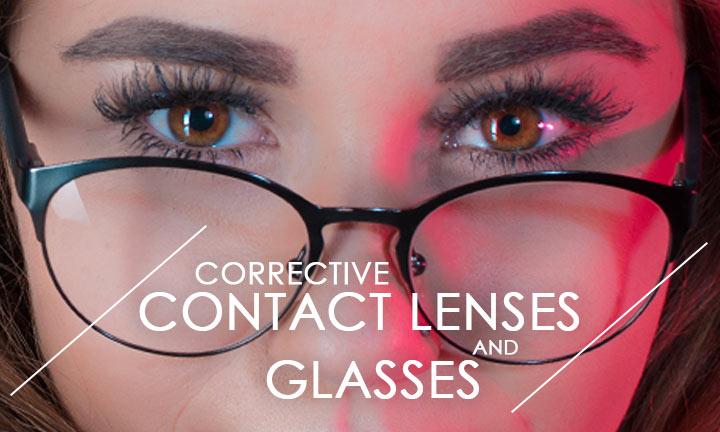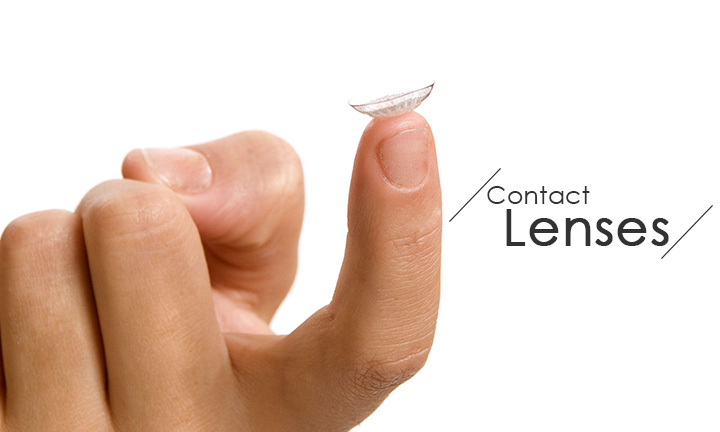4th, January 2019 | Oh Jinna
How do corrective contact lenses and glasses work?

To understand how they operate, let’s review a little eye anatomy and how corrective lenses work. Let’s focus on the eyes special membranes that in which the light flows.
The eyes consist of three eye walls in which the light should pass through. Let’s start from outermost to innermost layers.
First, light passes through the Fibrous layer the consist of Sclera and Cornea. Sclera is a rigid white external connective tissue that hold the structure of the eye, shields the underlying membranes and supports adjacent extrinsic eye muscles.
Cornea, “the window of the light” is a clear sheet of fibrous tissue where the light first passes through. As one of the eye’s focusing system, cornea screens the entering light which will either bends or refracts.
Now, moving to the next layer, we have the Vascular Layer which consists of Choroid, Ciliary Body, Lens, Iris and Pupil. Choroid is a very thin sheet of vascular tissue and melanin-rich membrane located behind the sclera. It is usually black which functions similarly to a camera firm.
These black sheets absorb light that has dispersed and reflected back in the eye’s focusing system. If light is reflected inside the eye, it may interrupt with vision. Ciliary body anchors the Lens, a biconvex flexible transparent disc.
Iris is the colored part of the eye which surrounds the Pupil. Iris regulates the diameter of the Pupil in which where the light passes. The pupil get smaller as the light increases intensity, while it widens as the light decreases intensity.
The vascular layer has trapped light which prevents light from spreading inside the eye thus enhances focus.
Lastly, the innermost layer consists the Retina or the Nervous layer, which has two partitions: the external pigmented retina and the internal sensory retina.
Pigmented retina functions similarly to the choroids. Sensory retina consists of photoreceptor cells called Rods and Cones and other several interneurons.
Rods are light sensitive and operates in very dim light however, they do not support color vision. Cones, though, provide color vision which will need enough light.
Why there is a need to have corrective contact lenses and glasses?
Someone is a candidate to have either corrective contact lenses and glasses if that someone is experiencing hard time recognizing.
Symptoms vary from different persons they may have blurry vision, headaches, their eyes hurt, have to squint to focus, see double vision, have difficult night vision and or see glitters around intense lights.
Some are caused by astigmatism in which their cornea is in ill-formed shaped that distorts passage of the light towards the retina. Some are refractive like myopia, hyperopia and presbyopia.
When light is disrupted it would further result to a blurred vision. Contact lenses and Glasses are made specifically to alter light direction so when it reaches the retina it will generate a clearer vision.
So, here’s your options Glasses or Contact lenses.
Glasses
Glasses or spectacles are prescription graded either hard plastic or glasses to aid vision that are held firmly by a frame. Usually are custom-made as per prescription.
Its technology makes light passes through the glass then refracts as it passes through the eyes to correct distorted images and give you an illusion of a perfect, clearer vision.
Glasses are now shatter resistant that are crafted to not to not easily break when dropped and has evolved to incorporate UV (ultraviolet) protection in each pair to strain harmful UV rays to directly contact the eyes.
On the other side, there are different types of glasses depending on use. There’s Concave lenses that are used for myopia (nearsightedness) and has a thin graded lens in the middle.
Concave lenses have diopters numerical prescription marked as a minus sign (-).
Convex lenses are next, these types of glasses have thick centers used to treat hyperopia (farsightedness) and its diopters numerical prescription marked with a plus sign (+).
Last on the list comes Cylindrical glasses, these are types used for astigmatism (irregular shaped cornea) which are curved in one side than the other.
PROS
Glasses are very affordable and they correct all types of vision problems in all age brackets. They also protect the eyes from external factors such as dust, strong winds and other foreign object that may cause eye irritation.
They are also easy to care and no solutions needed unlike contact lenses.
They stick to your nose by using frames and does not directly contact the eyes. These frames are very sturdy these limits the chance of frequent replacements.
You can also pick different frame designs and structure depending on your choice.
CONS
Glasses with high prescription may disrupt vision particularly at the border of the lens if you have. Others don’t like the pressure on the ears or the heaviness of the glasses on their nose.
Lenses fogged up, get sprayed in the rain and are not the best option for sports and other outdoor activities.
Contacts Lenses

Contact lenses functions similarly to the glasses is just that they come directly in contact to the eye.
Contact lenses are placed directly on the eye’s tear film creating a more convenient and natural way in aiding perfect vision when one’s eyes have refractive errors. Type of Contact lenses also varies depending on use.
Contact lenses may either be soft or rigid. Soft Contacts are very flexible, water based material that easily imitates the eye shape and are usually used for myopia, hyperopia and presbyopia.
The advancement of Silicone hydrogel material has been a great breakthrough. People are now allowed to use contact lenses in longer period while keeping the eye clear and healthy.
PROS
Contact lenses are very adaptable and fashionable. They are the ideal for sports and on fashion industry since you can change your eye color through the lens.
Contact lenses also provide better periphery vision and more enhanced vision acuity. Soft contact lenses provides protection from dust and smokes thus minimizing eye irritation.
Contact lenses now also offers UV light protection when glasses can’t be worn. Disposable Lenses are cozy enough for part-time lens user.
Some type of lenses also caters corrective treatments that slows the rate of progression in developing severe case myopia. Toric contact lenses also are crafted specifically for astigmatism.
CONS
Contact lenses should be cleaned thoroughly as per instruction, one must be patient enough to take good care of its after care. There’s an increased risk of eye infection since it has the direct contact on the eyes.
Dry eyes are the usual problem. Serious eye problems will be met if not being worn properly, especially over worn and worn while swimming. Illegally acquired contact lenses are quite dangerous as well.
Contact lenses has exponentially evolved ever since it is out in the market so as glasses.
Arguments between these two options are endless though extrinsic advancement in spectacle lens technology and the growing popularity of surgical involvements such as laser eye corrections has also been an option, the aid of contact lens for vision acuity remains reliable, efficient and economical in attaining comfortable clearer vision.
Consult your nearest eye care specialist for further instructions and choose the best option that will better suit your lifestyle.
Citations
Sclera and Cornea
https://www.ncbi.nlm.nih.gov/pmc/articles/PMC5819093/
Vascular layer
https://courses.lumenlearning.com/nemcc-ap/chapter/vision/Rods and Cones
https://www.cis.rit.edu/people/faculty/montag/vandplite/pages/chap_9/ch9p1.html
Symptoms
Contact lenses and Glasses
Eye Health: All Guides
Shatter Resistant
https://www.mydr.com.au/eye-health/eyes-in-the-sun
Disrupt Vision
Contact Lenses
https://www.allaboutvision.com/eye-exam/contact-lenses.htm
Soft contact lenses
http://www.visioncareresearch.com/resources/50-reasons-to-wear-contact-lenses.asp
Toric contact lenses
https://ohmylens.com/toric-lenses-for-astigmatismEye Infection
https://www.preventblindness.org/wearing-contact-lenses
Worn While Swimming
https://www.emedicinehealth.com/contact_lenses
Arguments
Contact Lenses or Glasses: Which is Better for You?


Leave a Reply
You must be logged in to post a comment.